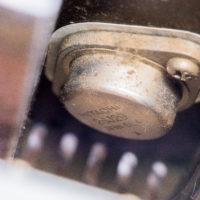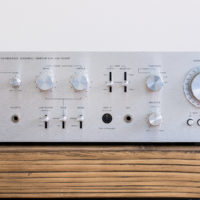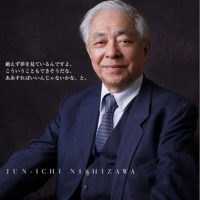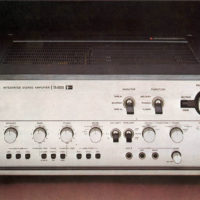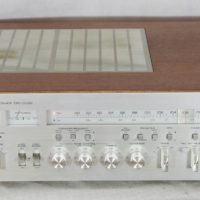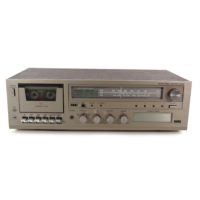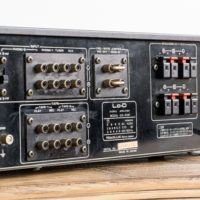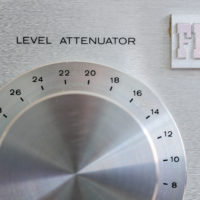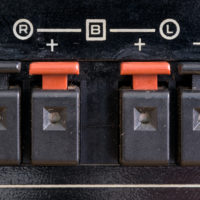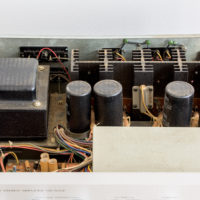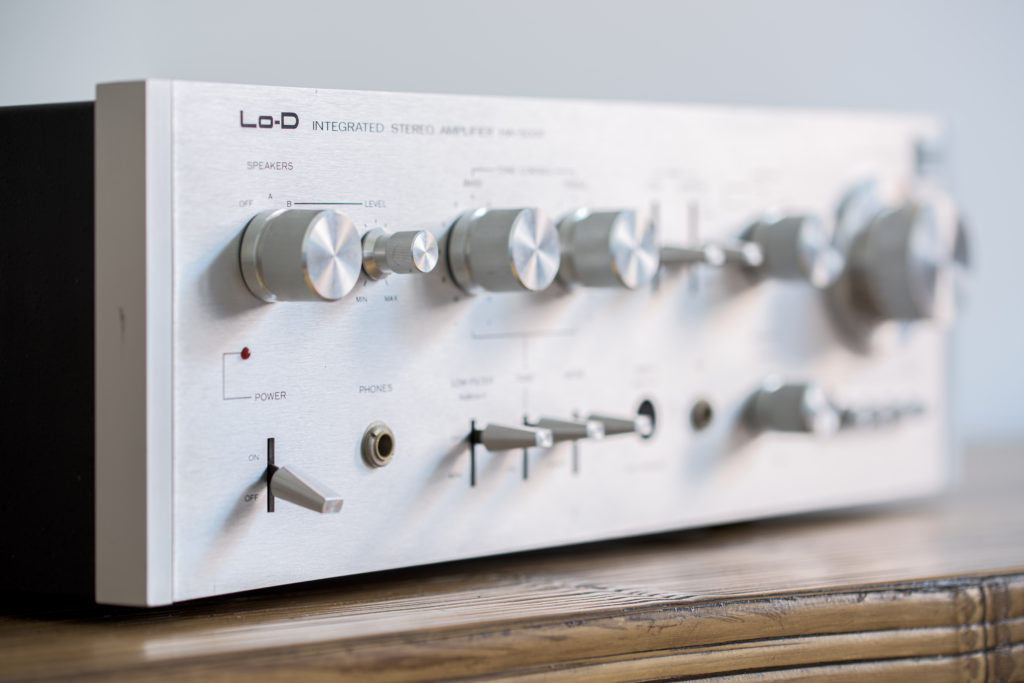
If you watched some of my previous reviews, you may have noticed I’m a sucker for V-FET amps. It was just a matter of time before I got this one, Lo-D HA-500F. It’s bloody difficult to find one of these anywhere and if you manage find one, she’s usually dead. The one I’ve got, was advertised as not working and actually she really wasn’t. But fortunately, it was only couple of dead caps and resistors, the most important part, the V-FET transistors that can’t be found anywhere anymore, survived.
500F is an integrated amp and I’m about to find out if it’s worth bearing the V-FET badge. And as always, let’s start from the beginning. And by the beginning I mean explanation what V-FET and integrated amplifier is. For those who know or watched my previous reviews, skip this bit.
V-FET
It may seem like I’m obsessed with the V-FET amps, and yea….maybe I am…. But they sound so bloody awesome, I simply can’t resist. It, of course, applies only for the ones I’ve already tested. V-FET or SIT or Power FET transistors were developed by Nishizawa Jun-ichi, known as Mr. Semiconductor, and rightly so, not only he was pretty good at his job, he was so obsessed with his work, he was actually thinking about naming his son after a transistor. And as him being Japanese, there were only Japanese companies utilizing V-FETs in their products. Yamaha, Victor, known as JVC outside of Japan, Sansui, SONY and Hitachi. Unlike Yamaha, JVC and Sansui, Hitachi and SONY also produced Integrated Amplifiers with the V-FET transistors.
V-FETs have very low noise, very low distortion and short turn-on and turn-off times. They say the V-FET is as close to triodes as transistor will get. And from what I’ve heard so far, it’s true. These transistors produce very warm and sweet sound, but unlike the valve amps, the sound is also very detailed. I hate to repeat myself, but these are one of the best amps, period. Either new or old, you can hardly find anything better than this, at least in a form of a power amplifier. This is my first V-FET integrated amp, so I hope it’s gonna sound as amazing as other V-FETs. The production ran only for couple of years, before everybody turned their backs on the V-FETs and started using much cheaper and easier to work with MOS-FETs and BJTs. The V-FETs can get quite hot compared to other transistors and need very precise and flawless power supply, otherwise they may quite easily end up dead.
Integrated Amplifier
There are basically two types of amplifiers, power amp and pre-amp. Power amp takes care of the amplification of the signal, while the pre-amp is there for volume control, additional inputs and outputs and slight signal pre-amplification. A good pre-amp shouldn’t worsen the sound quality, while an excellent pre-amp can even make it better. So, integrated amplifiers are basically power amp and pre-amp stuffed together into one chassis. Integrateds are more convenient, they take up less space and are considerably cheaper. But it also kinda means they are not as good as their bigger sisters, most of the time. There are some exceptions of course, but generally they are inferior.
Then we’ve got a receiver. It’s a type of integrated amplifier with a tuner thrown in. If you don’t want to use the radio, don’t even consider using a receiver. If the integrated amplifier is inferior to the power amplifier, the receiver is, of course, even worse. There’s more electronics that can interfere with the sound, more electronics that take up space in the chassis and thus less space for the amplifier itself.
And if you want to lower the quality even more, you may try to find a cassiever, it’s a combinations of power amp, pre-amp, tuner and cassette deck. Amplifier part, tuner part or a cassette deck part everything’s pretty much rubbish in this one, but if you need all of those for some reason and you lack space for more than one device, it’s kind of way to go.
Brief history
Hitachi is of course Japanese brand and Japanese always produced the best equipment. Hitachi products are known in Japan as Lo-D which is an abbreviation of Low Distortion. Hitachi makes about anything, some systems for cars, construction machinery, military systems, nuclear power generators, various electronics, etc., etc. What we are interested in, are of course audio systems, amplifiers to be precise. They’ve made some extraordinary products, like the first ever MOS-FET power amp, which was supposed to be a V-FET killer. Was it though? I’ll certainly find out one day. Or the excellent DAD-1000 which has been cloned about billion times. Unlike SONY’s masterpiece TA-8650 that cost 300 000 yen in 1974, which is about £5000 today, the 500F wasn’t Hitachi’s hi-end by any stretch, it cost “only” 90 000 yen. Even though it looked very similar, Hitachi’s hi-end was HA-1100. It’s not that big of a surprise, but as well as many other Japanese electronics, the 500F was released only in Japan.
Features
She’s not the most powerful amp in the world, she’s got only 50W into 8 ohms per channel. But it’s just enough for most home loudspeakers running at normal listening levels. Signal to noise ratio is not one of the best, only 100dB, but it’s perfectly acceptable. The distortion, however, is not so good. Well, at half the power, the distortion is 0.008%, which is excellent, although at full power, it rises up to 0.3%, and that doesn’t correspond much with the name Lo-D (Low Distortion). I tried pushing the power to maximum to test if I can hear the sound deterioration and unfortunately, I certainly could. It wasn’t something terrible, but if you want to enjoy the music, don’t push it too hard. If you want to use a turntable, you’ve got two phono inputs, unfortunately they’re only for MM cartridges. If you want tu use an MC cart, you need some sort of external phono amplifier and if you want to use ceramic cart, just connect it to the auxiliary or tuner input. Phono 1 is hard set to 2mV and Phono 2 is switchable between 2 and 5mV. Also, you can’t play around with impedance, it’s hard set to 50kohm for both phono inputs.
Design
I’m a sucker for electronics made in seventies, I know it’s a personal taste, but they almost always look amazing. All of these knobs, buttons and levers on the brushed aluminium panel look cracking. It’s not the best design I’ve ever seen, there are better looking pieces out there for sure, but the 500F is certainly pretty. What I’m missing though, are VU meters. They always kinda light up the front panel and make the amp look more alive. The piece I’ve got is the basic model, it cost almost 90 000 yen in 1975 and if you fancy the wood finish, you could’ve bought her in the wooden chassis for another 6500 yen. Personally, I fancy the amp in the wooden chassis a tad more. She’s solidly built, all the buttons, knobs and levers are firm, nothing feels loose or knackered even after so many years.
The power lever is quite self-explanatory, just push the lever up, wait for the relay to click and you’re ready to go. You can connect up to two pairs of loudspeakers. You can either turn the speakers off completely, use A channel, B channel or both. What is quite an interesting knob, though or function, is Level knob. It works only when the speakers are connected to the B channel, but that’s not the interesting bit. The interesting bit is, why it’s there in the first place. Well, the amplifier allows you to bypass pre-amp, which switches the amp to a sort of power amplifier mode and since the volume knob is a part of the pre-amp, you can’t use it, it won’t work. Like this you may use some external pre-amp or you have to control the volume through your sound source. And if you can’t do either, that’s what this level knob is there for. It lowers the volume level when you have no other way of controlling the volume when the pre-amp is disabled. I reckon I don’t need to explain what bass and treble do. They work fine, you just need to enable them with different lever there. I don’t fancy using bass and treble on the amplifier, I fancy keeping the sound as neutral or flat as it gets. Low filter is there for one reason, anything bellow certain frequency is cut off, in this case it’s anything bellow 40Hz. That’s good for getting rid of turntable rumble for example, which I never had a problem with or any lower frequency for that matter, so I never use this feature on any amplifier. Function knob switches between different inputs. Nothing special here. Same goes for the balance. Phones output… I never understood why would anybody listen to the music on these devices using headphones, but almost every amplifier’s got it. It’s not a big problem, but the volume control is not very smooth, it’s got only 22 positions, so if you feel like one position is too quiet and the next one is too loud, you’re either out of luck or you need to compensate some other way.
The back plate is not overpopulated, we’ve got couple of sections there. Phono, tuner and auxiliary in the input section. Tape 1 and tape 2 in the tape section, pre-main jumper and of course speakers. I’m sure, I don’t need to explain any of these, however, pre-main jumper section is quite useful. If you want to use the amp only as a pre-amp, you can connect your external power amp to the pre-out, so the internal power amp is cut off and if you want to use the 500F as a stand-alone power amp, you can connect your source to the main-in and it cuts off the pre-amp section. As I said before, when the pre-amp is cut off, you can’t use the volume attenuator or any other sound enhancement pots, like bass or treble. Speaker terminals are a piece of crap. They are not as terrible as the ones used in Yamaha’s B-2, but they are pretty bad. At first sight, you can see they are pretty dodgy. At second sight and touch, you are actually afraid, they will break off.
Inside
On the outside, the chassis’ quite cool. The warmest part is of course where the transistors are and I wonder, how the transistors themselves do. So, let’s have a look inside, then. It’s bloody dirty, outright disgusting and I’m not going to clean it up right now. The amp is not chock-a-block with electronics and heat sinks, it’s rather empty, it weighs only about 26 lb which is about 12 kg. The channels are not separated too well, it’s got only one transformer for both channels, and it certainly doesn’t scream top quality.
Caps still look original, however, it doesn’t mean it’s a good thing. Unlike the transistors, electrolytic capacitors’ lifespan is, unfortunately, limited. Depends on usage and how old it is. Anything above 20 years is considered not good, but that doesn’t mean they can’t survive much longer. The heatsinks where the transistors are look rather dodgy. 500F uses Hitachi’s own transistors, which were used only in this particular model. And that may be bit of a problem, because if the transistors go, it’s nearly impossible to fix the bloody thing.
Sound
The sound is a tad disappointing but on the other hand it’s surprisingly good. Yeah, it sounds a bit mental, let me explain. It’s an integrated amp and certainly not hi-end, so I shouldn’t have expected anything more than what I’ve got. Compared to the Yamaha B-2 or B-3 which I’m used to, the sound is a bit dry and not so sweet and warm. The mids and highs are not so clear and it lacks the detail the Yamahas’ got. Soundstage is a tad worse as well, it lacks the space and air, but the bass is deep and nice. 500F does everything worse than Yamaha B-2 or B-3 but that’s quite understandable. That being said, for what she is and what she initially cost, she’s actually exceptionally good. There’s one part of the amp that may be important for lots of people, and that is included phono pre-amp, which is quite good. MM cartridges sound great, I can’t say anything bad about them. However, to get MC cart to some normal listening levels, I had to crank the volume up to the half. It was a bit noisier but at least it wasn’t distorted. So, she’s not a perfect candidate for turntables with MC carts. For what she cost when she was new, she sounds really good, I’d even call it excellent. I don’t want to compare her to Yamaha’s power amps, it would be unfair, since she’s an integrated amp. They’re not on the same level, but compared to the Yamaha CA-2000, 500F is very close.
Conclusion
Today’s price can go up to £2000, which is ridiculous. I’ve paid about £1700 and I kinda regret that, so I’m gonna let her go. The price is so high, mainly because she’s bloody rare, but she’s also an excellent integrated amplifier as I already said couple of times. Well, is she worth the money she costs today though? For V-FET collectors, perhaps. After all it’s probably the rarest of all V-FET amps. For somebody who just wants high quality amp to listen to music, definitely not. You can find better amps for lower price. That said, she’s still a piece of history and I’m happy to have been able to test her and hear what she’s able to produce.
